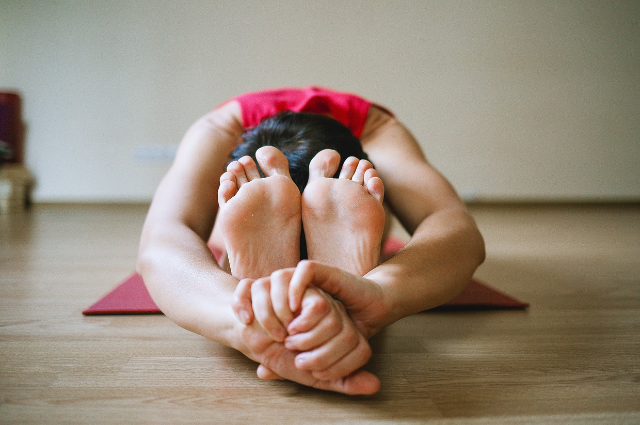
Desk yoga
Desk yoga is a practice that is suitable and ideal for sedentary jobs. It offers many physical and mental benefits for people who are used to sitting for prolonged hours for their job. There will be lots of work pressure, which can cause stress, and also pain at those times; desk yoga can serve as a remedy and give relaxation. which helps the mind for coordination.
Poses of desk yoga
Seated crescent moon
Begin by lifting your arms overhead, connect the palms and stretch your fingers wide. Gently lean to one side for 2-3deep breaths. Repeat on the other side,
Crescent moon pose gives a deep stretch to your sides, lengthening your spine and allowing you to return to your work with better coordination.
Chair pigeon
Whilst seated, place one leg over the other at a 90-degree angle, flexing the foot so as not to place pressure on the knee. Remain in an upright position, keeping an even distribution on both seat bones. When you feel a gentle to moderate stretch in the upper outer thigh, hold it for 10-15 breaths. And repeat on the other side.
Seated pigeon pose helps us regain the balance we sometimes lose sitting in our desk chairs, whilst opening the hips and chest.
Sit and stand chair pose
Begin in a seated chair position with your feet flat on the floor and your knees at a 90-degree angle. Pressing down with your heels and using your legs and glutes only, make your way to standing on your leg muscles without shifting the hips from side to side. This pose can help awaken the hamstring and glute muscles that become weakened over time from sitting in a desk chair.
Standing seal pose
Begin this pose in a standing position, stepping your legs 3-4feet apart. Inhale the arms behind you, interlacing the fingers together. Squeeze the shoulder blades together and lift the gaze upwards before folding forward at the hips, bringing your arms in front of you. Keep the legs and arms straight, hold the pose for 4-8 breaths. To release the pose, squeeze the shoulder blades together as you inhale back to an upright position. Exhale to release the arms.
The standing seal pose stretches both the spine and legs, opening the shoulders. It also harmonises the connection between the heart and mind, improving mental function.
Wrist and finger stretches
Begin by extending your arms overhead and drawing 5-10 circles inwards and outwards with the wrists. Follow this by quickly spreading the fingers and closing the fists, releasing excess tension. Finally, place your arms in front of you, with your palms facing upwards, and gently apply a downward pressure on each side. Switch the palms to face downward for a counter stretch of the forearms. Hold each stretch for 5-10 breaths.
Working at a desk can build up tension in the fingers, hands and wrists, so these exercises should be done often throughout the day to increase the blood flow.
Desk yoga for eye detox
Eye yoga generally focuses on strengthening the muscles around the eyes with a set of exercises. This can help reduce eye strain and improve focus. It’s particularly beneficial for those who work in environments that require prolonged focus on screens or other tasks that can lead to eye fatigue.
This set of exercises can be done anywhere and at any time.
Palming
Gently rub your palm until you feel the warmth, then place your hands over your eyes. Rest your fingers on your forehead and your palms over your eyes, with the bottoms of your
hands against your cheeks. This exercise doesn’t necessarily support muscle building around the eyeball, but it gives your eyes a break from stimulation of all types.
Eye rolling
Sitting straight up, relax your face and then roll your eyes without moving your head. Then, roll your eyes to look directly above your head. Then roll your eyes as large as possible, going in a clockwise direction three times. Next, switch to a counter-clockwise direction and repeat the exercise another three times.
Focus shifting
If you’ve been staring at a screen for a long time close to your face, just stretch your arm in front of you with your thumb extended in a thumbs-up. Keep your eyes trained on your thumb as you slowly move it closer to your face, in a straight line, until it touches your nose. Pause for a few seconds and then extend your thumb back out until it’s in the starting position again. Repeat this exercise while keeping your eyes focused on your moving thumb.
Distance gazing
This is similar to focus shifting. This exercise is beneficial if you want to allow your eyes to focus on something else while in a meeting or another environment where it might be inappropriate to start waving your thumb around. Just look out into the distance and focus on a particular object or spot as you keep your face relaxed before moving your focus to another object in the distance for as long as your eyes need.
Candle gazing sunlight gazing
Which improves the sight and sharpens the vision, it’s an ancient practice for vision, focus and inner strength too. This improves concentration and balances the nervous system. Just stand in a place where you can focus sunlight properly; it’s good to be before sunrise. Focus for about one minute and gradually increase the timing every day. You can even try with candlelight, too.
Eyeball rotation in water
This helps to clean our eyes and improve our eyesight properly. After you wake up from bed, dip your face under water in a bowl, then rotate your eyes in clockwise and anti-clockwise directions.
References
- centreforesight.net
- Thirdleafnw.com
